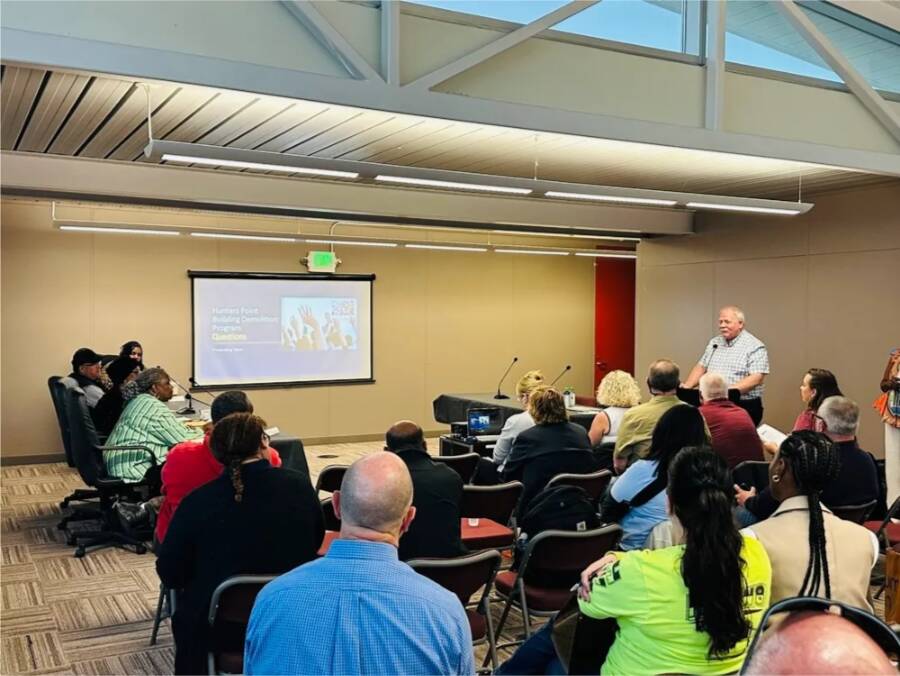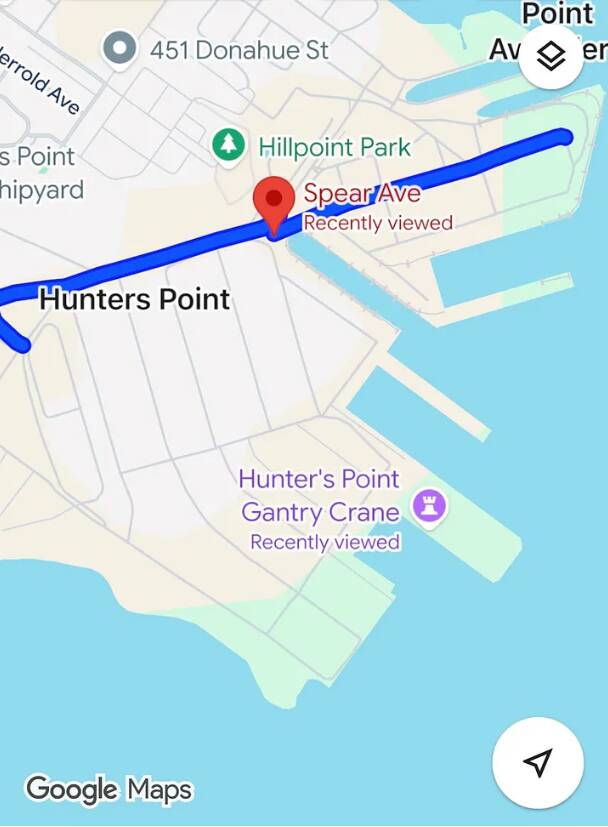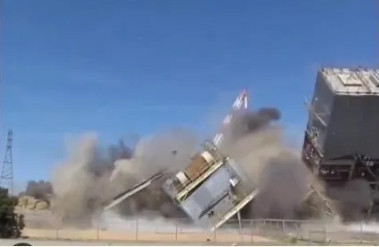
by Ahimsa Porter Sumchai MD
The explosive truth
Paraphrasing prolific science fiction author Frank Herbert’s quote in “Dune Messiah” from the Ancient Fremen saying: “Four things cannot be hidden — love, smoke, a pillar of fire and,” allow me to add, explosive truth!
The Navy proposes to explosively demolish six radiologically impacted buildings sited on radiation contaminated soils and concrete at Hunters Point Naval Shipyard Federal Superfund Site Parcel G and to parade chemically contaminated hazardous waste through the Palou Avenue residential neighborhood to the major transit and commercial center on Third Street.
Navy BRAC Environmental Coordinator Michael Pound confirmed at the July 28, 2025, meeting of the Hunters Point Shipyard Citizens Advisory Committee (HPSCAC) that the Navy intends to explode clouds of toxic dust within a quarter of a mile from the Parcel A condominiums and truck radioactive and chemically contaminated hazardous waste down Palou Avenue to Third Street in a region ranked in the 95th to 100th percentile for air toxics by CalEPA EnviroScreen and EPA EJ Screen.
According to complaints filed in 2021 by Public Employees for Environmental Responsibility, the state of California allowed the U.S. Department of Energy to dynamite two radioactive buildings without required dust control, and without notifying local authorities. The Santa Susana Field Station demolition site, located 30 miles from downtown Los Angeles, is the site of a nuclear meltdown and multiple releases of radioactive and toxic chemicals (see https:/peer.org/radioactive-buildings-dynamited-near-la/).
Explosive demolitions spew particulate matter 2.5 and PM 10. World War II era buildings located on Parcel G spew asbestos, lead and carcinogenic heavy metals, compounding health hazards in the city neighborhood ranked highest in cardiorespiratory diseases, COVID-19, infant mortality and Stage II breast cancer incidence and mortality.
Bayview Hunters Point is a community at heightened risk from airborne particulates compounded by seasonal wildfires, construction dust, diesel particulates from trucks, RVs, school buses and unregulated polluting industries. It is a maligned community with an indoor smoking incidence of 4.5%.

The NAVFAC Building Demolition Map documents Navy plans to explosively demolish six buildings outlined in yellow on Parcel G: Buildings 401, 411, 439, 366, 351 and 351A. Building 401 is located at the heavily trafficked intersection of Spear Avenue (UC-1) across the street from residential Parcel A. Building 401 is not suitable for explosive demolition, and manual demolition should be analysed in the NEPA mandated Environmental Impact Review.
“Please add to the Executive Summary text that Parcel G has Cesium-137 contamination due to the Navy’s activities,” according to the EPA Review of the Navy’s June 2018 Draft Parcel G Removal Site Evaluation Work Plan, Page 1.
A production crew captured footage for the PBS/NOVA documentary “Critical Condition” overlooking Drydock 4 and the northern boundary of Parcel G. Food trucks are parked along unfortified chain metal fences lacking dust barriers on Spear Avenue at Parcel G. North of Drydock 4 on Blandy Street are piles of radioactive waste left uncovered over the weekend by Navy contractors. This March 12, 2024, photo was verified and authenticated by the Office of the Navy Inspector General in Norfolk, Virginia, and appears in the PBS/NOVA documentary “Critical Condition.”
“The 2004 HRA indicates that Cesium-137 was found at high concentrations in sediment from a manhole along Cochrane Street. The HRA documents the Navy used Cs-137, resulting in liquid waste that resulted in releases in Building 364 in piping, sinks, and the “peanut spill” behind the building. The HRA also documents in Table 5–1 that the Navy held five radioactive licenses with the Atomic Energy Commission for Cs-137, one for a quantity of 3,000 Curies and a separate quantity of 20 Curies of Cs-137,” according to the EPA Review of the Navy’s June 2018 Draft Parcel G Removal Site Evaluation Work Plan, Page 1.

The understanding of consequences
The Navy is engaged in concealment, data manipulation, document substitutions and violations of federal Superfund law in a flailing attempt to erase the radiological history and human health risks of the explosive demolition of MARSIMM Class I contaminated buildings, soil, concrete and media on Parcel G of the Hunters Point Naval Shipyard Federal Superfund Site. Parcel G is a region best conceptualized as the western boundary of the runway to the Gun Mole Pier — described by the Nuclear Regulatory Commission as “the loading point for nuclear waste.”
“Ecology is the science of understanding of consequences” — Frank Herbert, DUNE Chronicles
Like a pillar of smoke and fire, many burning, unsolved questions are raised about the Navy proposal to demolish radiologically impacted buildings on MARSIMM Class I radiation contaminated federal Superfund Site Parcel G.
How did the Navy remediate buildings located on the corridor leading to the Gun Mole Pier on a coastline at extreme risk of sea level and ground water rise to the degree that, when scanned for radionuclides of concern, there were “None Detected” when it is estimated it will take 20,000 years to remediate Chernobyl?
Why does the Navy propose to explosively demolish Building 401, located at the heavily trafficked intersection of Spear Avenue and H Street — across the street from Parcel A residences, playgrounds and food trucks? If Building 401 requires demolition, doesn’t it make common sense to manually demolish a building in a sensitive location?
Hunters Point Community Biomonitoring Program conducted urinary toxic exposure tests on a Hunters Point senior in 2022 diagnosed with Acute Leukemia and Basal Cell Skin Cancer. The urinary biomonitoring test detected elemental arsenic, cesium, nickel, thallium, strontium and potassium in toxic concentrations. The patient consented to undergoing a 24 hour urinary assay capable of detecting radioisotopes conducted by environmental toxicologist and expert witness James Dahlgren Medical. The extraordinary results detected two radionuclides determined to be atomic bomb residues: Plutonium 239 and Uranium 235.
Navy representatives and apologists argue findings of the Parcel G Human Health Risk Assessment published in the 2009 Parcel G Record of Decision do not accurately represent the remediation status of Parcel G today. The BRAC Environmental Coordinator documents in his July 28, 2025, presentation that the remediation status of Parcel G is only 60% complete. Until the Navy recalculates the HHRA based on 2025 status, the Final 2009 Parcel G ROD remains legally sacrosanct!
SF Bay View Health and Environmental Science Editor Ahimsa Porter Sumchai, MD, PD, founder and principal investigator for the Hunters Point Community Biomonitoring Program, founding chair of the Hunters Point Naval Shipyard Restoration Advisory Board’s Radiological Subcommittee and contributor to the 2005 Draft Historical Radiological Assessment, can be reached at AhimsaPorterSumchaiMD@Comcast.net. Dr. Sumchai is medical director of Golden State MD Health & Wellness, a UCSF and Stanford trained author and researcher, and a member of the UCSF Medical Alumni Association Board of Directors.




